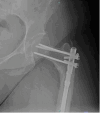The Off-Label Use of a Humeral Nail To Treat a Subtrochanteric Femur Fracture: A Case Report
- PMID: 39958107
- PMCID: PMC11830416
- DOI: 10.7759/cureus.77505
The Off-Label Use of a Humeral Nail To Treat a Subtrochanteric Femur Fracture: A Case Report
Abstract
The use of humeral nails for femoral subtrochanteric fractures is rarely reported. We present a case in which a humeral nail was employed for a subtrochanteric femur fracture alongside contralateral prophylactic stabilization of the femoral neck and shaft. A 29-year-old female patient with a history of bilateral varus-producing proximal femoral osteotomies, complicated by symptomatic hardware indicating bilateral removal, sustained a subtrochanteric fracture. Given her 98-degree neck-shaft angle, a humeral nail was selected for right femur fixation. She also underwent prophylactic stabilization of the contralateral proximal femur with a humeral nail. There are limited options for addressing subtrochanteric femur fractures in patients with anatomy variations that preclude using standard femoral nails. This case demonstrates the successful off-label use of a humeral nail for subtrochanteric femur fracture when a traditional femoral nail is impossible.
Keywords: congenital hip dysplasia; femoral neck osteotomy; femoral neck-shaft angle; im nail; subtrochanteric femur fracture.
Copyright © 2025, Buseck et al.
Conflict of interest statement
Human subjects: Consent for treatment and open access publication was obtained or waived by all participants in this study. Institutional Review Board, Upstate University Hospital issued approval N/A. Submission to the IRB was not required for this case report. Patient consent was obtained. Conflicts of interest: In compliance with the ICMJE uniform disclosure form, all authors declare the following: Payment/services info: All authors have declared that no financial support was received from any organization for the submitted work. Financial relationships: All authors have declared that they have no financial relationships at present or within the previous three years with any organizations that might have an interest in the submitted work. Other relationships: All authors have declared that there are no other relationships or activities that could appear to have influenced the submitted work.
Figures





References
-
- Subtrochanteric femoral fractures. Lundy DW. J Am Acad Orthop Surg. 2007;15:663–671. - PubMed
-
- Femoral shaft fractures in adults: treatment options and controversies. Gänsslen A, Gösling T, Hildebrand F, Pape HC, Oestern HJ. https://achot.cz/artkey/ach-201402-0002_femoral-shaft-fractures-in-adult.... Acta Chir Orthop Traumatol Cech. 2014;81:108–117. - PubMed
Publication types
LinkOut - more resources
Full Text Sources
Medical
